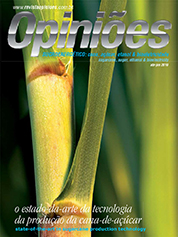Nilson Augusto Villa Nova
Professor of Climatology at Esalq-USP
Op-AA-24
Relation between climate and the feasibility of seatting up a sugar and ethanol production company
A variety of climate factors influence the planting, growth, development and productivity of a region. They are, ordered by importance: machine mobility in the planting and harvesting seasons and lack of rain during the cycle.
Machine Mobility in the planting and harvesting seasons: The possibility of using different types of machines is highly dependent on rain, given that, if machines cannot operate, the following facts occur:
a. sugarcane cannot be supplied to mills for crushing;
b. if the mills lack sugarcane, the fuel in the process – bagasse burnt in boilers – must be replaced by oil or coal, significantly increasing production costs;
c. since the electric power source in mills is the turbo-generator, driven by steam produced in boilers, the power output decreases and thus the entire pumping system of juice and water is adversely affected, causing a delay in different production phases.
d. in the 2009 harvest, in several regions in the country, excess rain prevented the harvesting of a considerable portion of the produce in due time, resulting in losses; e. concerning the expected productivity, one knows that it is highly dependent on total solar energy and temperatures in the growth period. A productivity model based on these factors was presented in a paper by me and others in 2005.
Lack of rain during the cycle: One may express the hydric deficit (D) of a cycle phase of a plantation by the equation:

Where the terms mean:
ETR: actual evapotranspiration or the quantity of water needed in any given cycle phase (in mm period).
ETP: evapotranspirational potential. This represents atmospheric demand (resulting water loss from transpiration in the period).
This equation shows that when the water quantity needed by the plantation (ETR) is equal to the potential atmospheric demand, the base’s deficit is zero (0%). A technical publication by FAO sets the sugarcane production deficit according to the following equation.

Where the terms mean:
Ya: expected production for certain hydric deficiency values (1 - ETR/ETP) in any given phase.
Ym: expected production potential with zero deficit (ETR = ETP).
Ky: coefficient that measures the importance of the water deficit in each phase.
The values of Ky for each of the growth bases are thus related to the FAO publication. The Ky value, also called the “plantation coefficient” of the phase, is shown in the Table bellow. One may also observe that in practice excess rain in the maturation phase accounts for an increase in agricultural output and a probable decrease in industrial output (low saccharose concentration and high concentration of reducer sugars).
One may furthermore observe that the model developed by this author et al to estimate output shows that a decrease in available solar energy (intensive cloudiness with rain) will also determine a decrease in potential productivity due to the reduction in available solar energy.
One should also notice that mobility is contingent on the type of soil and the terrain’s slope angle. What characterizes excess humidity or the deficit in each phase is the climate hydric balance. The average climate hydric balance of different regions in Brazil, as elaborated by Sentelhas and others, shows average values for ERT/ETP in 500 localities.
One may conclude that the lack of rain in the vegetative development period, or its excess in the harvesting period, are the main factors influencing good output and operational conditions of mills and distilleries; according to the Table, the highest penalization (Ky = 1.05 to 1.30) occurs in the phase of maximum vegetative development (near the end of the cycle). In the paper by this author and others, the influence of solar radiation and temperature (without the lack of water) in the production of sugarcane’s final biomass is clearly shown.





